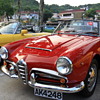Posted 11 years ago
 Chrisnp
Chrisnp
(310 items)
Here’s the bayonet I’ve displayed with my Australian SMLE.
This pattern bayonet began issue when the SMLE was introduced in 1907. Originally Pattern 1907 bayonets had a hooked quillion. Both the English and Australians stopped making them with quillions early on, and removed the quillions from most of the pre-existing bayonets, so now those are quite hard to come by. One of my goals it to get a quillioned Australian marked P07. One can always dream.
One thing I’ve noticed is that in the late 19th and early 20th century, whenever a country produced a shorter rifle, they tended to make a longer bayonet, I presume to make up for the shorter reach. Bayonet fighting was still considered a form of fencing, and the image of two soldiers both armed with bayonets, thrusting and parrying with each other was still on the minds of military planners. This blade is nearly 17” long. What appears to be a muzzle ring on the bayonet’s cross guard actually fits over a projection on the SMLE’s muzzle cap as seen in the photo above.
Like my SMLE, this bayonet was produced at Lithgow Armory, but much later, in 1944. During this time the woodworking shop at Lithgow was moved to Slatzenger in Sydney, thus the grips on this bayonet are stamped “SLAZ”. The leather and steel scabbard are also marked “MA” – the code for Lithgow Armory. This overall condition of this bayonet leads me to presume it was also refurbished after WWII.


















The "SLAZENGER" took my attention CHRISNP. Living in Sydney myself I went looking for some detail about the Slazenger works. Their main factory was in Alexandria not too far from where I live. Another in Putney and another in Surry Hills.
Tennis was big in the pre-war years here in Australia!
I found this piece of oral history:
Reg speaks -"I was in the VDC, the Volunteer Defence Course, which was mainly for people who had to stop at home and work on essential services. When I left school I worked at the sawmill with my father on the other side of Dunns Swamp on the Coricudgy Mountain, cutting timber for Mosquito Bombers. We had enough coachwood timber there to build the first 72 Mosquito Bomber frames they had at the beginning of WWII. The frame was made out of timber and plywood was also made out of the timber and covered some of the frame, then it was covered with canvas.
The Mosquito Bombers were made at Richmond, Sydney, the timber prepared on machinery by the Slazenger tennis racquet factory. We cut the timber and railed it to Sydney. Slazenger also made the framework for the 303 rifles, cutting the stock and sending it to Lithgow Small Arms Factory to be made up into rifles.
The Mosquito Bomber motors were made in England by Rolls Royce. I often wondered if they were too powerful for the body, if they were to open up the engine, the plane would have fallen apart, it was so powerful. But the Mosquito Bombers were one of the fastest bombers."
http://www.mudgeehistory.com.au/rylstone_kandos/rylstone_kandos34.html
Slazengers were involved in boatbuilding too!
http://www.ryde.nsw.gov.au/About+Ryde/Historic+Ryde/Historic+Places/Slazengers+Shipyard
Many thanks for your postings here on CW on ANZAC DAY.
Thanks for the quick education on Slazenger! The story about the mosquito bombers reminds me of the original Boeing aircraft plant, not to far from where I live. The location was chosen because of it's proximity to spruce timber for aircraft frames, and Boeing's wood manufacturing expertise before WWI came from boat builders.
Anyway, thanks for your response. I'm glad my posts were appreciated.
Thanks for the love Manikin, geo26e, racer4four and vetraio50.
Hey vetra, that was great, especially since I'm into guns & aircraft. I knew there had to be a connection and you provided it. Well, maybe just an excuse for tying them together. The 109's tails were wood & cloth & made in home work shops too.
The long bayonets make for better display. Much better than the spike.
Fortapache, give me a long, quillioned, brass handled bayonet any time!
Thanks for love AmberRose, fortapache, packrat-place and blunder.